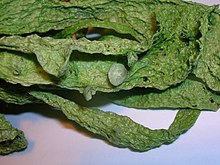
Sarcographa is a genus of lichen-forming fungi in the family Graphidaceae. It is estimated to contain 37 species. The genus was circumscribed by French botanist Antoine Laurent Apollinaire Fée in 1825.
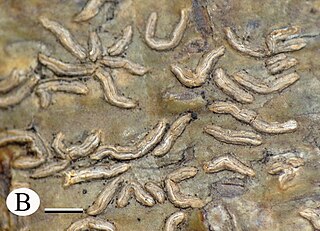
Phaeographina is a genus of lichen-forming fungi in the family Graphidaceae. The genus was circumscribed by Swiss lichenologist Johannes Müller Argoviensis in 1882.

Graphis is a genus of lichen-forming fungi in the family Graphidaceae.
Pyrgillus is a genus of lichen-forming fungi in the family Pyrenulaceae. The genus was circumscribed by the Finnish lichenologist William Nylander in 1858.

Myriotrema is a genus of lichen-forming fungi in the family Graphidaceae.
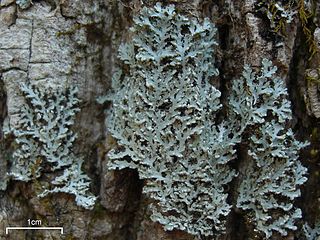
Heterodermia is a genus of lichenized fungi in the family Physciaceae. The genus has a widespread distribution, especially in tropical regions, and contains about 80 species.

Pyxine is a genus of foliose lichens in the family Caliciaceae. The genus has a widespread distribution in tropical regions.

Myelochroa is a genus of foliose lichens in the family Parmeliaceae. They are commonly known as axil-bristle lichens. It was created in 1987 to contain species formerly placed in genus Parmelina that had a yellow-orange medulla due to the presence of secalonic acids. Characteristics of the genus include tightly attached thalli with narrow lobes, cilia on the axils, and a rhizinate black lower surface. Chemical characteristics are the production of zeorin and related triterpenoids in the medulla. Myelochroa contains about 30 species, most of which grow on bark. The genus has centres of distribution in Asia and North America.

Bulbothrix is a genus of lichen-forming fungi in the family Parmeliaceae. This genus is synonymous with Bulbothricella V.Marcano, S.Mohali & A.Morales. Bulbothrix was circumscribed by lichenologist Mason E. Hale in 1974 with Bulbothrix semilunata as the type species.
Syo Kurokawa was a noted Japanese lichenologist and 1994 recipient of the Acharius Medal. He studied under Mason Hale and Yasuhiko Asahina.
Héctor Saúl Osorio Rial (1928–2016) was a pediatrician, bacteriologist, and lichenologist from Uruguay.
Nipponoparmelia is a genus of five species of lichen belonging to the family Parmeliaceae. Nipponoparmelia was originally conceived by Syo Kurokawa as a subgenus of the genus Parmelia in 1994. It was raised to generic status in 2010. Four east Asian species were originally placed in the genus; Nipponoparmelia perplicata, found in South Korea and Russia, was added in 2014.

Ramalina americana, commonly known as the sinewed ramalina, is a pale green fruticose lichen that is found across the Northern US Midwest, extending into Southern Canada and the Eastern Seaboard. It is characterized morphologically by the presence of pseudocyphellae, straight spores, and its unique chemical diversity.

Platythecium hypoleptum is a species of corticolous (bark-dwelling), crustose lichen in the family Graphidaceae.
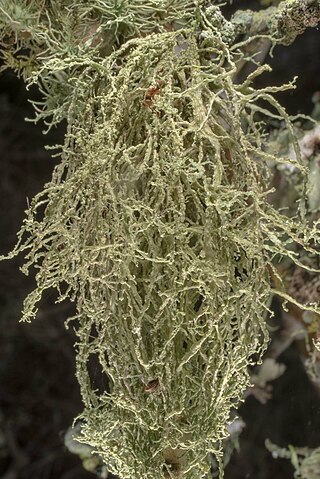
Ramalina peruviana is a species of fruticose lichen in the family Ramalinaceae with a pantropical distribution. The lichen was first formally described by Erik Acharius in 1810, who wrote of its flat, compressed, branching thallus with narrow, undulating branches. It typically occurs on the bark of trees (corticolous) although occasionally it grows on rocks (saxicolous). Ramalina peruviana is widely distributed, found in subtropical and warm temperate regions across several continents. It has been recorded in diverse locations such as Pacific Islands, the southern United States, East Africa, Asia, Australasia, and South America. Its presence has been documented in specific habitats like mangroves in Australia and on certain tree species in Taiwan and China, where it thrives at higher elevations.
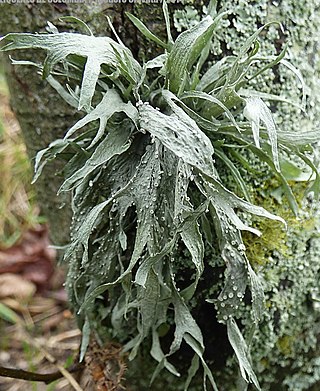
Ramalina celastri is a species of corticolous and lignicolous, fruticose lichen in the family Ramalinaceae. It is a widespread species with a pantropical distribution.
